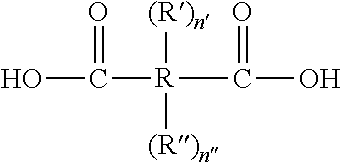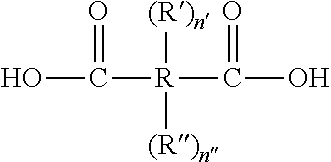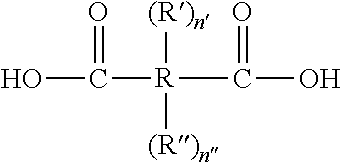Sanitizing and cleaning composition and its use for sanitizing and/or cleaning hard surfaces
a technology of sanitizing and cleaning compositions, which is applied in the preparation of detergent mixture compositions, biocides, detergent compounding agents, etc., can solve the problems of visual inspection of equipment that cannot ensure the cleanliness of surfaces, interfere with the growth of desired microbial organisms during food processing, and disrupt the killing mechanism of microbicides, etc., to achieve the effect of improving surface wetting and soil removal
- Summary
- Abstract
- Description
- Claims
- Application Information
AI Technical Summary
Benefits of technology
Problems solved by technology
Method used
Image
Examples
Embodiment Construction
Preparation of the Compositions
[0090]Each of the following compositions was prepared by admixing the ingredients listed in the following table 1 in sequential order, blending thoroughly by agitation and allowing each ingredient to completely disperse or dissolve in the liquid mixture before addition of the next ingredient. The resultant compositions were clear and homogeneously uniform upon admixture of all listed ingredients. Compositions A1 to A4 contained the quaternary antimicrobial system of the present invention. Composition B1 is a comparative acidic composition corresponding to a prior art represented by presently commercially available compositions for standard CIP applications.
[0091]
TABLE 1CompositionA1A2A3A4B1softened Water (%)38.041.035.035.015.0phospate ester (%)4.04.04.0cumene sulfonate (%)15.015.020.020.030.075%-H3PO4 (%)——35.0—40.053%-HNO3 (%)30.030.0—35.0—70%-glycolic acid (%)5.05.06.56.5—octanoic acid (%)2.02.01.01.02.0N-octenyl succinic acid6.03.02.52.59.0(%)
Test ...
PUM
| Property | Measurement | Unit |
|---|---|---|
| temperature | aaaaa | aaaaa |
| temperatures | aaaaa | aaaaa |
| temperature | aaaaa | aaaaa |
Abstract
Description
Claims
Application Information
 Login to View More
Login to View More - R&D
- Intellectual Property
- Life Sciences
- Materials
- Tech Scout
- Unparalleled Data Quality
- Higher Quality Content
- 60% Fewer Hallucinations
Browse by: Latest US Patents, China's latest patents, Technical Efficacy Thesaurus, Application Domain, Technology Topic, Popular Technical Reports.
© 2025 PatSnap. All rights reserved.Legal|Privacy policy|Modern Slavery Act Transparency Statement|Sitemap|About US| Contact US: help@patsnap.com



